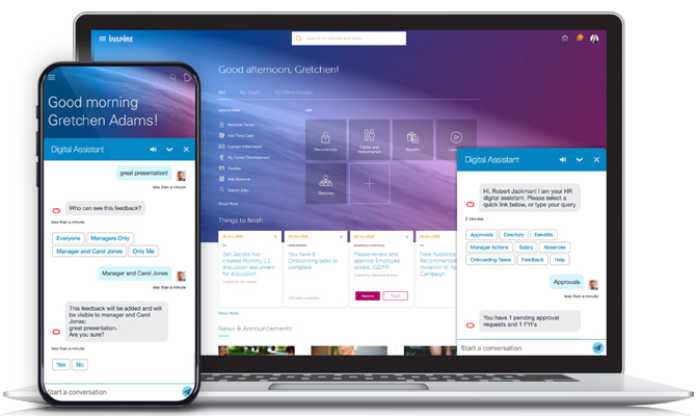
Oracle launched new features for Oracle HCM Cloud in a bid to make both the employee and candidate experiences simpler, more personal and more mobile.
The company’s starting point is the idea that workers today want fast, easy-to-use systems, personalized content and anywhere/anytime access. To respond, Oracle says, HR departments must rethink their approach to the entire employee experience.
.@OracleHCM launched new features in a bid to make both the employee and candidate experiences simpler, more personal and more mobile. #HR #HRTech Click To Tweet“We hear from our customers that their employees are expecting [a consumer-style] experience when they come to work and they’re not getting it,” Emily He, senior vice president of marketing for Oracle HCM, told us in an interview. “So we’re at the point where we really need to rethink the experience of enterprise software and start delivering this more consumer-like experience.”
That means helping users to easily get things done.
- Chatbots and other self-service tools make more capabilities available through a simpler interface that can be accessed across multiple channels including voice, SMS, desktops or mobile devices.
- Workforce planning capabilities allow HR to drill down for supply-and-demand data by key categories such as person, job or skills. Meanwhile, HCM Design Studio now eliminates the need for coding when creating employee experiences tailored, say, to different business units or roles.
- Talent acquisition tools include Tailored Career Sites, which companies can use to create multiple sites to target different candidate types. It also includes simplified interview scheduling and self-service tools candidates can use to check their application status and other information.
Usability Means Flexibility
Oracle’s approach to this release seems centered on its digital assistant capabilities. “With the Oracle digital assistant, our customers can create a competitive advantage by delivering a seamless, conversational user experience that we know employees want,” Chris Leone, Oracle HCM’s senior vice president of development, said in a statement.
In essence, digital assistants are the new interfaces to Oracle HCM. Depending on the customer’s choice, they can be accessed by voice, SMS or more traditional channels like web interfaces. The digital assistants offer more functionality, He said, but a big part of their job is to simplify user interaction.
“Now when I come to the office I don’t need to log into the system, figure out which tab I need to click on, figure out which business process I need to execute and go through these steps. I’m just asking a question and expecting work to be done,” she explained.
Users can also the interface that’s appropriate for that particular moment. For example, they might ask questions via voice when they’re driving and SMS if they’re multi-tasking during a meeting.
HR’s Own Digital Assistants
.@Oracle says HCM’s new digital assistants are the first to be purpose-built for #HR. #HRTech #HCM Click To TweetAccording to He, Oracle HCM’s digital assistants are the first to be purpose-built for HR. “There are a lot of chatbots out there, but [with them] you have to build a chatbot for your own company. But this is something we’re delivering out of the box,” she said.
To create the assistants, identified common employee questions, thought through the different ways they could be asked and provided a set of answers for each query. “In some ways it’s sort of a decision tree,” He said, but because it allows users to interact using natural language through avenues they’re comfortable with—such as voice and SMS—they “feel more at ease and have a more engaging experience.”
Behind the scenes, Oracle HCM tracks usage to determine the workforce’s frequent concerns. “We can now start gathering data on how they’re asking the questions, what questions they’re asking, and the system will become smarter over time,” He said. “Our hope is the machine will learn over time and deliver even smarter recommendations and insights.” She described the system as being “like a first-generation digital assistant that we’re delivering to enable a more engaging HR help desk.”
Oracle’s approach also takes advantage of the company’s cross-functional experience. Particularly interesting is how the workforce planning module helps HR and Finance work more closely together. Talent and skills can be included in budget analysis, for example. So, an organization entering a new market could look at required skills and competencies, then estimate its talent costs. “It’s a really integrated planning process between finance and HR,” He said. New releases of workforce planning will add more elements to the equation.
Sign up for our newsletter here.
Image: Oracle















